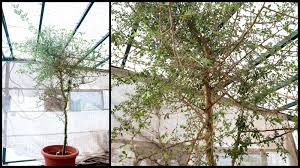Scientists Grow 1,000-Year-Old Seed into Ancient Biblical Tree, Potential Cancer Cure Identified
A remarkable scientific breakthrough has emerged from the Judean Desert, where an ancient seed, dating back nearly 1,000 years, has been successfully germinated into a 10-foot-tall tree named “Sheba.” This seed, discovered during an archaeological excavation in the late 1980s, is believed to belong to a lineage of trees mentioned in the Bible, sparking interest among scientists regarding its potential medicinal properties


A remarkable scientific breakthrough has emerged from the Judean Desert, where an ancient seed, dating back nearly 1,000 years, has been successfully germinated into a 10-foot-tall tree named “Sheba.” This seed, discovered during an archaeological excavation in the late 1980s, is believed to belong to a lineage of trees mentioned in the Bible, sparking interest among scientists regarding its potential medicinal properties.
The seed, which dates between 993 AD and 1202, was found in a cave and has taken 14 years to grow into the impressive tree it is today. Researchers assert that “Sheba” may be linked to an extinct species of trees that once thrived in the regions now known as modern-day Israel, Palestine, and Jordan.
Healing Properties and Biblical Connections
Scientists are particularly intrigued by the tree’s potential to produce “tsori,” a resin mentioned in biblical texts for its healing properties. They believe that the revival of this ancient tree could unlock the secrets behind the mysterious Biblical balm. Additionally, “Sheba” is related to the Commiphora species, which produce fragrant resins associated with the Biblical “Balm of Gilead.”
While initial hypotheses suggested that “Sheba” might be a candidate for the historical “Judean Balsam,” researchers have since refuted this idea, noting that the tree lacks aromatic properties. Nevertheless, chemical analyses of its leaves have revealed active compounds with anti-inflammatory and anti-cancer properties, suggesting that the tree may indeed hold significant medicinal value.
Potential for Further Discovery
Further studies of “Sheba” have revealed antioxidant and skin-smoothing properties in its leaves and stems. Researchers believe that the tree represents an extinct lineage once native to the region, and they emphasize the importance of continued investigation into its characteristics and possible applications in medicine.
Despite its impressive growth, the “Sheba” tree has yet to flower or produce any reproductive material, which hinders deeper scientific exploration into its properties. Scientists remain hopeful, stating that there may still be undiscovered species of the Judean Balsam, and the potential for growing more ancient trees from other archaeological finds continues to spark curiosity.
As research progresses, the revival of “Sheba” may not only shed light on historical practices related to healing but also contribute to modern medicinal advancements, particularly in the fight against cancer. The implications of this discovery are profound, intertwining ancient history with contemporary science and medicine.
Sources By Agencies








Bedava iPhone kazan SEO optimizasyonu, dijital pazarlama stratejimizi güçlendirdi. http://royalelektrik.com/
This was beautiful Admin. Thank you for your reflections.
order ventolin online no prescription: Ventolin inhaler price – can you buy ventolin over the counter in uk
buy ventolin online cheap
ventolin mexico: Buy Albuterol for nebulizer online – where to buy ventolin